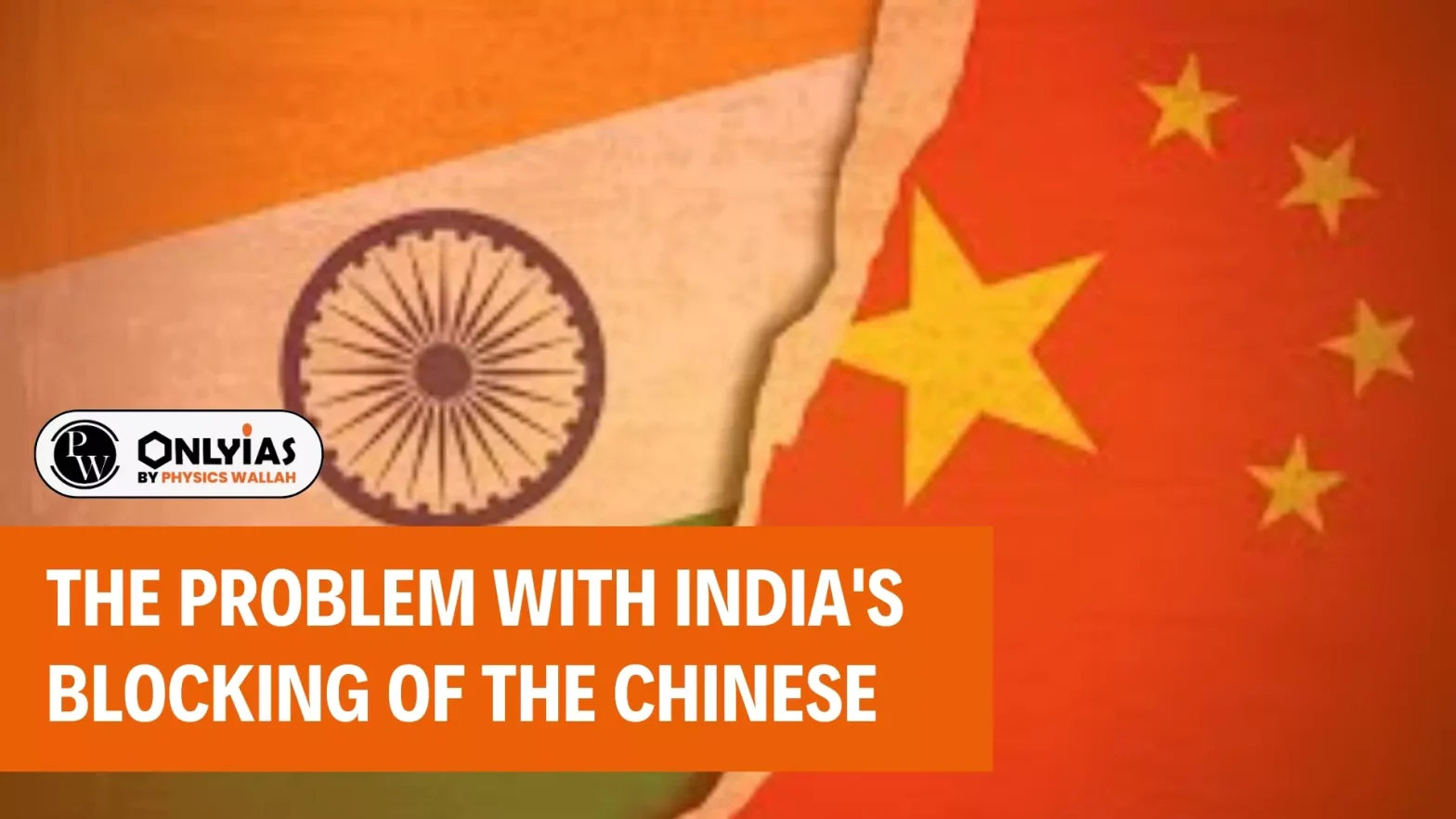Indian authorities have promised more visas to Chinese technicians, whose help Indian businesses urgently need.
| Relevancy for Prelims: Programme for International Student Assessment (PISA), Organisation for Economic Co-operation and Development (OECD), etc.
Relevancy for Mains: Challenges in skilling youth population, Current skill development ecosystem in India, Government programs in addressing the skill gap, etc. |
Problem with India’s Blocking of the Chinese
- Rajesh Kumar Singh, Secretary, Department for Promotion of Industry and Internal Trade, recently accepted claims by Indian companies that “a significant skill gap” exists between Chinese and Indian factory supervisors and workers.
- As a Vellore-based shoe manufacturer explained, Chinese professionals are “highly productive.” They can “help you produce 150 items with the same resources with which we produce 100″.
- The Engineering Export Promotion Council of India’s chairman has joined the call for more visas for Chinese technicians.
- From footwear and textiles to engineering and electronics, Indian businesses have purchased machines from China but cannot use them productively without the help of Chinese technicians.
- Leaders of Indian industry associations keep reminding officials that the machines are lying idle, and export orders unfulfilled.
- Gautam Adani’s solar manufacturing facility is also awaiting visas for Chinese workers.
- The official acknowledgement of India’s huge skill deficit is important and impressive.
- Rarely is there such clarity that even “low-tech”, labour-intensive production requires a deep well of expertise.
- China honed exactly this expertise over the past 40 years to become the world’s manufacturing hub.
- Its experts are less expensive than those from elsewhere.
- Yet, while the government has few, if any, restrictions on international experts, it holds the Chinese back, citing national security concerns.
- This is a problem.
- The Chinese can help India secure a foothold on the lowest rungs of the global skills’ ladder.
- Those rungs are rising: India must jump on now.
- But especially since the government is already slow walking its promise of more visas to the Chinese, this moment must trigger action on the real culprit: woeful Indian education.
- For, despite the hype, the world is not waiting for India.
- Without foreign technical assistance and vastly upgraded domestic education (as also in China), job-rich prosperity will remain a cruel mirage.
Enroll now for UPSC Online Course
Discouraging Visa Prospects
- In 2019, Chinese nationals received 2,00,000 visas, but the numbers fell sharply after deadly clashes between Indian and Chinese troops in 2020.
- Indian officials accused the Chinese of violating visa conditions and laundering money to evade India’s tax laws.
- Last year, the number of visas to Chinese personnel was down to 2,000.
- A security-driven mindset has taken root.
- This year, even the meagre 1,000 visas for Chinese electronics professionals are stuck in a “pipeline”, undergoing “intensive screening”.
- Despite positive noises by Commerce and Industry Ministry officials, a cabinet Minister, who chose to remain anonymous, tempered expectations.
- “Visas,” the Minister said, “will be issued for Chinese technicians and businessmen only after screening with assurance that travel conditions will not be violated”.
- Such “screening” might well kill this initiative with a thousand cuts.
Integrating Foreign Knowledge
- East Asian economic history teaches us that foreign knowledge is pivotal but spurs development only when combined with adequately educated domestic workers.
- Weak Indian education makes foreign expertise especially urgent.
- In the 1980s, Korean businesses bought foreign machines to dismantle and reverse engineer them.
- By then, Korea had nearly three decades of a solid educational foundation and needed minimal human assistance.
- They sourced foreign knowledge as was embodied in machines.
- China began its explosive growth in the early 1980s with a weaker education base than Korea’s.
- However, the breadth and the quality of Chinese primary education – achieved during the Communist era – had primed it for rapid development, as a World Bank report predicted in 1981.
- To enhance domestic capabilities, Deng Xiaoping – better known for special economic zones and Tiananmen Square – sent senior policymakers on international study tours and sought foreign investors willing to bring global knowledge to China.
- Once again, the interaction of domestic and foreign knowledge proved potent, propelling China to become the world’s global manufacturing hub.
- India, in the meantime, built more school buildings and enrolled more children in schools. But as the surveys of learning outcomes depressingly remind us, the schools have rarely educated the children.
- Stanford University’s Eric Hanushek – the world’s pre-eminent scholar on the tight relationship between education quality and growth – points out that only about 15% of Indian school students have the basic reading and arithmetic skills required for an international economy; 85% of Chinese children have those skills.
- And China is not standing still. Since 2018, Chinese school students have bettered the world’s best in the Programme for International Student Assessment (PISA) conducted by the Organisation for Economic Co-operation and Development (OECD).
- Successive PISA evaluations and internal Chinese assessments show ever-larger numbers of Chinese children achieving world-class levels of learning.
- India participated in a 2009 PISA evaluation, and dropped out after a cringe-worthy performance.
Check Out UPSC NCERT Textbooks From PW Store
The Red Queen Race
- China, for all its faults and problems, has learnt a fundamental lesson that the Red Queen imparted in Lewis Carroll’s Through the Looking Glass.
- You must run twice as fast as you can to stay in the same place.
- You must run faster than that to get ahead. Chinese universities are among the world’s best, especially in computer science and mathematics.
- Chinese scientists are making advances in various applied sciences of relevance to industrial progress.
- A world leader in electric vehicles and solar technology, China is ready to breach the inner sanctums of artificial intelligence.
- Indian and international elites seem unable to learn the lesson from China’s example.
- The economists Rohit Lamba and Raghuram Rajan have mistakenly given up hope of generating Indian jobs for the, as yet, vast global market for labour-intensive products.
- Instead, they say that India must grow jobs in technology-enhanced service exports.
- This proposition ignores the tiny base of high-quality Indian university education.
- And as the historian Mukul Kesavan’s poignant description of Delhi University’s decay reminds us, Indian leadership is eviscerating some of its best institutions.
The Reality in India
- Undeterred by such evidence, Martin Wolf of the Financial Times predicts that India – a country that cannot educate its children and provide its vast millions with dignified jobs – is on course to be a global economic superpower.
- However, India has all-but-missed the China- plus-one window.
- Mexico (due to its strategic location) and Vietnam (well-located and possessing exceptional human capital) seized this opportunity when barriers descended on Chinese products.
- In fact, foreign investors are shying away from India, and India’s labour-intensive manufactured exports (goods exports minus petrochemicals and chemicals) are stuck at a 1.3% share of global market.
- India’s spurt in technology-related service exports during the COVID-19 years has come to a grinding halt.
- Even graduates from the Indian Institutes of Technology are struggling to find jobs.
- Many formerly at the bottom rungs of Bengaluru’s IT economy in support, maintenance, and basic coding roles – are seeking opportunities in the gig economy.
- IT jobs have fallen off their peak of just above five million in 2023, which itself was minuscule in a working-age population of a billion people and a workforce of 600 million.
- Make no mistake, if national security and self-reliance mantras block even the baby step of visas for relevant foreign experts, India will miss another opportunity for a new beginning.
- With dysfunction in school and university education and an overvalued rupee, any prospect of labour-intensive manufactured exports will die again.
- India must address its severely deficient human capital rather than harbouring fanciful notions of its place in the world.
- The global Red Queen race is intensifying.
- More windows will close as increased millions helplessly await dignified jobs.
Enroll now for UPSC Online Classes
Conclusion
India can overcome its skill deficit and global challenges by investing in education reform and embracing foreign expertise, paving the way for robust economic growth.
![]() 31 Jul 2024
31 Jul 2024

